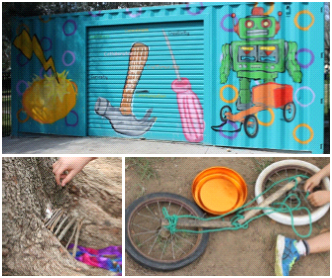Welcome to Loose Parts Play!
In this article I hope to share enough information to inspire you as a parent, carer, grandparent or teacher to create opportunities for this form of play in your home or school setting.
The theory of Loose Parts Play involves providing opportunities for children of all ages to engage with everyday materials that can be moved, carried, combined, repurposed and redesigned, taken apart and put together in endless ways. A car steering wheel, old letterbox, bike wheel, handle, or pedals, cloths, cubby making blankets, pots and pans, old phones, pebbles and shells, plumbing pipe sections, planks, crates, tiles, seedpods and sticks — make any number of these items accessible to children and you have created the opportunity for Loose Parts Play.
This type of play encourages creative thinking, open ended learning, and personal and social growth. It allows children to make their own choices, develop their own ideas, solve problems and explore their world and how they relate to themselves and others.
At home, Loose Parts Play can be set up on a small or large scale. Your very own garage, a Salvos store and Tiny’s Green Shed at the Recycle depot can be great sources of materials. Then, decide how to store the items and rotate the loose parts by adding new items and taking away objects that have been well loved. At school, Loose Parts Play can be set up and made available as part of recess and lunchtime to enhance play outside by providing a richer environment than a landscape of fixed equipment and concrete.
At our Early Childhood School, we set up a Loose Parts shed using a ‘retired’ shipping container and spruced it up thanks to the fantastic talent and child-friendly collaboration of local visual artists Geoff Filmer and Dan Byrd.
Our shed is not open during free play (25 minutes of outside play after morning tea and lunch), as we already make available a variety of balls, bikes and sand play items at those times. Instead, the Loose Parts Shed is opened during weekly outdoor learning sessions run by the release teacher. This model allows for explicit teaching of safety and risk, skills in rope work structures, and a focus on the Dispositions for Learning (also known as Capabilities in the Australian Curriculum) of curiosity, creativity, collaboration, commitment, communication, craftsmanship and confidence.
These dispositions are a core part of our school curriculum and are taught explicitly during both indoor and outdoor learning throughout each day. In 2016, class teachers will be bringing their own group out to a Loose Parts Play session as part of their weekly schedule, with the aim of further embedding this type of play into the range of learning environments provided for children at our school.
I hope that this helps light or fuel a spark of interest in providing Loose Parts Play opportunities for the children in your care. ●
For more information, contact Jackie Neill: This email address is being protected from spambots. You need JavaScript enabled to view it.
This article appeared in ParentACTion, Term 1, 2016. See other past editions of our quarterly magazine.
